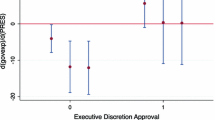Conclusion
An improved specification of the model used by C-T reveals that governors in those states where constitutional methods are used to determine gubernatorial compensation may have greater incentives to expand their respective state budget and, in doing so, increase their pay. The additional evidence offered in this paper suggests that such uses of discretionary power may be negligible or effectively blocked by competing groups. Thus, employing a more rigorous testing of the applicability of marginal productivity theory to the determination of gubernatiorial compensation supports the C-T contention that governors' pay may be determined in ways quite similar to those of comparable private factor markets, viz., by the competitive process.
Similar content being viewed by others
References
Crain, W. Mark, and Tollison, Robert D. “State Budgets and the Marginal Productivity of Governors.”Public Choice 27 (Fall 1976): 91–96.
Author information
Authors and Affiliations
Additional information
The author wishes to thank Mack Ott and Robert Tollison for helpful comments on an earlier version of this paper. A special debt of gratitude goes to W. Mark Crain who supplied, in addition to data, valuable insight and encouragement to the author. Any errors are the responsibility of the author.
Rights and permissions
About this article
Cite this article
Hafer, R.W. State budget sizes and the marginal productivity of governors: An extension. Public Choice 32, 143–149 (1977). https://doi.org/10.1007/BF01718677
Issue Date:
DOI: https://doi.org/10.1007/BF01718677




